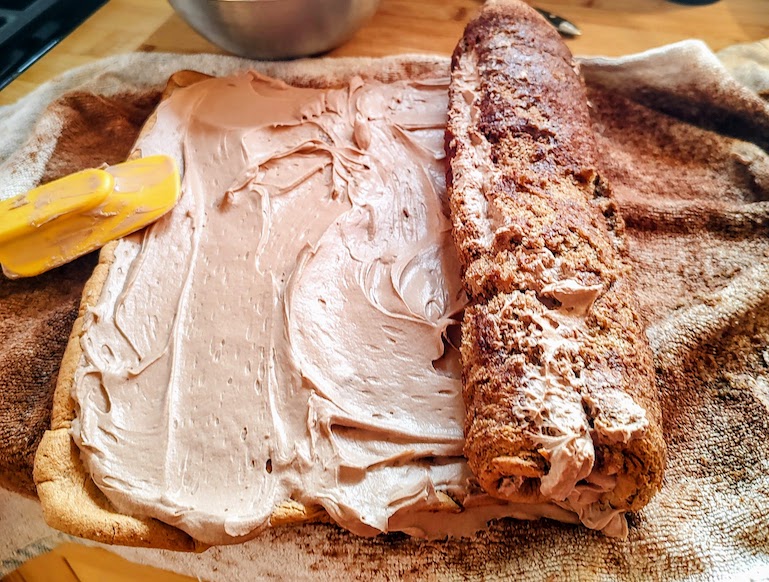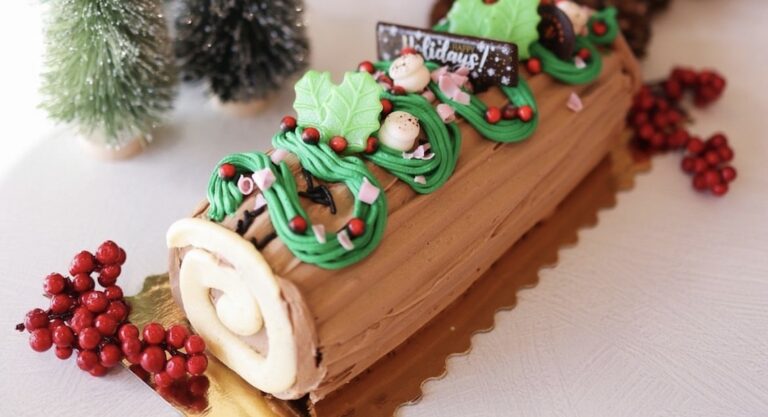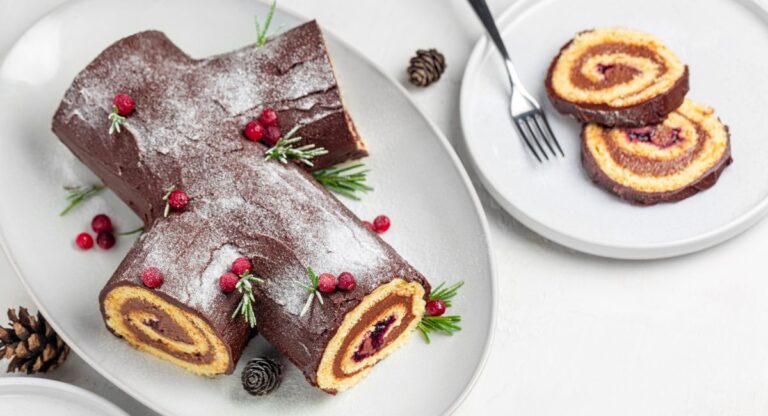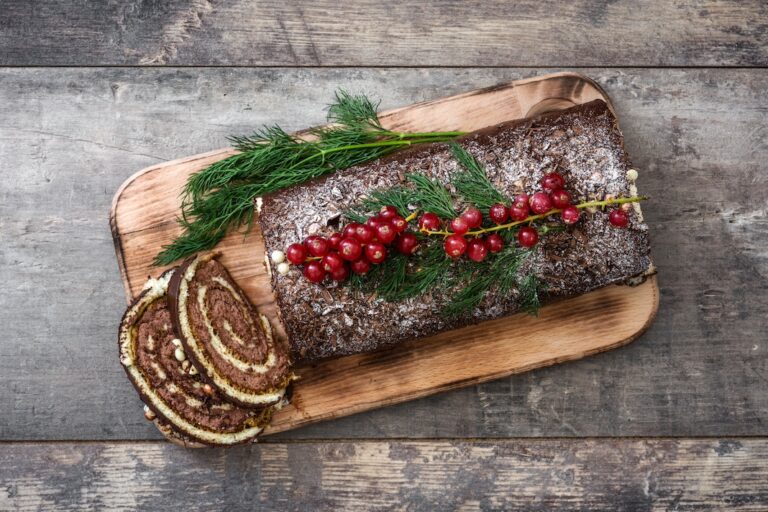When I decided to make a Bûche de Noël for this month’s column, I thought, it’s a Christmas cake! How complicated could it be? Wouldn’t a traditional Christmas recipe take into account how harried we all are this time of year?
And then I started researching recipes.
Reader, if you’ve ever made one, I don’t have to tell you that this is not just a cake. It’s a multi-step, time-consuming, challenging construction project. It’s a commitment. It requires patience and a couple of handy baking tools that I don’t happen to possess, one of which is a piping tube, the other of which is decorative flair.
Like everyone else I know, I glue myself to the Great British Baking Show every season, if only for the vicarious thrills of watching spectacular failures and triumphs that have nothing to do with me. It’s always been an escape, something distant from my own experience. But now, as I whipped and piped and baked and rolled and sugared and chilled, I heard the genteel, slightly mocking voices of Prue Lieth and Paul Hollywood in my head, expressing their sincere doubts at my abilities, politely questioning my methods, and gently urging me to greatness.
Even without the challenge of impressing those two culinary snobs, I refused to fail. A Bûche de Noël, done right, is a thing of French traditional holiday festive beauty, a chocolate log fallen in the snowy woods covered in mushrooms and pine sprigs and holly berries, defying botanical verisimilitude. (Done wrong, of course, it’s a big gloopy lump covered in gloopy smaller lumps, but I refused to even think about that.)
As far as I can tell, the French Christmas log was invented by a Parisian pastry maker in 1870 who wanted to create an edible version of the Christmas Eve ritual of burning a log in the fire that goes back to the Celts. How this morphed into giving the eater the experience of stumbling upon that log in a snowy forest, presumably to bring it home for the festive hearth, I have no idea. But I love it. I love everything about this Yule Log, especially the fact that it looks like a kitschy Victorian ceramic figurine. Christmas is the most over-the-top, glitzy, stressful, hectic, gilded festival I know of, and the Bûche de Noël is its edible showstopper. So what better way to add to the pressure of the holiday season than a two-day baking extravaganza to make something that goes perfectly with tinsel and shiny bows and The Ray Conniff Singers’ Christmas album?
This is not a baking undertaking for the faint of heart: it calls to mind the fact that fools rush in where angels fear to tread. The cocoa sponge has to be both light and tough, so you have to bake it exactly long enough, and then it has to roll up without crumbling, and then it has to unroll the next day and roll up again, this time holding in its whipped cream filling. The ganache has to be just liquid enough to pour, and then it has to solidify into fork-tined bark. The sugared cranberries and rosemary sprigs need to look both edible and frost-rimed, and the meringue chocolate mushrooms must be both delicious and plausibly fungal.
Adding to my challenge was the fact that I made my Yuletide cake both gluten- and dairy-free; I used coconut whipping cream for the filling and ganache, and Cup 4 Cup gluten-free flour for the sponge cake.
As I put the finishing touches on my cake, placing the cranberries around the rosemary sprigs and attaching the mushrooms to the ganache, I could almost feel that Hollywood handshake coming my way. I proudly paraded my Bûche de Noël around, posing it in various spots for photos as if it were a new puppy or an Oscar statuette.
And then we ate pieces of the cake for dessert garnished with cranberries and meringue. I had no idea whether it would taste as good as it looked. Would gluten-free flour be good in a sponge? Would the coconut cream in both the ganache and whipped filling be luxurious enough? The answer is yes, and yes, and I am here to inform you without false modesty that I am this week’s Star Baker.
In the end, it was so much fun to make this elaborate confection, and I recommend that you make it, too. You’ll wow your family and friends with the result, because not only is this cake beautiful and impressive-looking, it’s delicious: light, creamy, and chocolatey.
And then you too can get a Hollywood handshake as you’re crowned Star Baker of the week, if only in the fantasy world of your own head.
Joyeux Noël, mes amis!
Bûche de Noël
Here is a link to the excellent, clear, just-about-perfect recipe I used from Sally’s Baking Addiction, one of the best baking sites in existence. It is a step-by-step guide that is clear and not at all hard once you get in the swing of it all. I watched the video, read the entire set of instructions thoroughly before I started, and followed every step exactly as written. I made the following substitutions in a one-to-one amounts to adapt for a GF and dairy-free cake, ganache, and whipped filling.
GF Sponge Cake: Substitute equal parts GF flour for the cake flour in the sponge cake and follow the rest of the recipe exactly.
Dairy Free Whipped Filling: Substitute the same amount of coconut whipping cream, chilled overnight in the refrigerator, and otherwise make the recipe as directed.
Dairy Free Ganache: Substitute the same amount of coconut whipping cream for the heavy whipping cream and use dairy-free chocolate. Chill the ganache only until it reaches a spreadable consistency, not until it hardens (about one hour).
Note #1: I highly recommend going the extra mile and making the meringue mushrooms, even without a piping tube (I cut off the end of a plastic Baggie and filled it with the meringue mixture).
Note #2: For the sugared cranberries and rosemary, use half the amounts of water and sugar called for.
Note #3: Don’t worry if your cake cracks or tears a little! You can glue it together with ganache and filling so it looks perfect. (Fix it in post, in other words.)
And as a special holiday bonus, here’s your soundtrack:
Kate Christensen is a novelist, memoirist and food writer based in Taos, New Mexico. This essay is the tenth in a monthly series about French food called Bouffe, created and written exclusively for Frenchly by Kate Christensen. Her books, Blue Plate Special, How to Cook a Moose, The Last Cruise and more can be purchased here, on Amazon. Her next book, a novel, will be published in 2023.
All photos are courtesy of the author. To see more of Kate’s photos of food, family, the writing process, books and her darling pups, visit her on Instagram, here.













